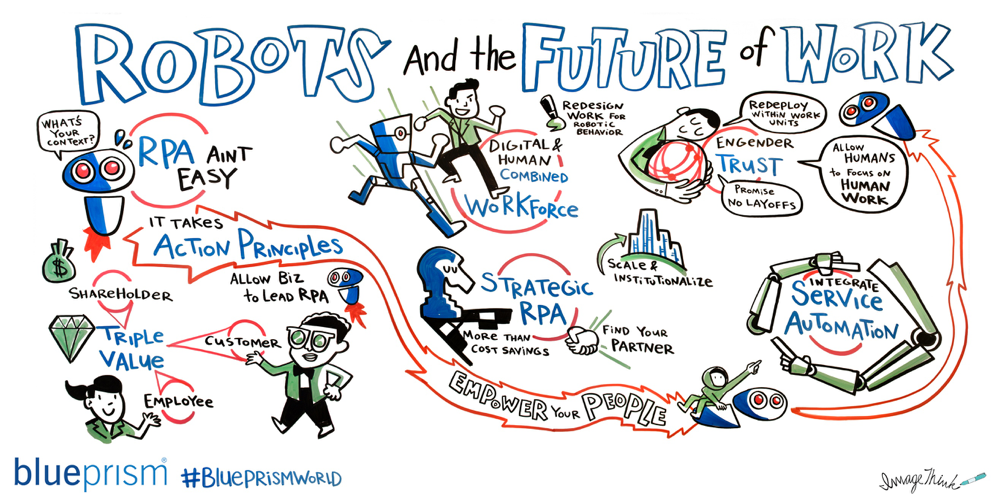Our new book Robotic Process and Cognitive Automation – The Next Phase (www.SBPublishing.org), sees major qualifiers to the argument that robotic process and cognitive automation will create massive job losses in the next phase of what the World Economic Forum, amongst others, has called the Fourth Industrial Revolution. There will be, in most cases, parts of jobs automated rather than whole jobs, there will also be job creation. The speed of technology deployment is exaggerated, likewise the perfectibility of the technology. We need to factor in the dramatic increase in the amount of work to be done together with productivity and skills shortages across many leading economies. Moreover, what humans bring to work that machines will not be able to across the next 35 years is being greatly downplayed. That said, we recognize two ‘big picture’ issues that will further shape the future directions and impacts of automation.
The first is that robotics and the automation of knowledge work, as represented by robotic process and cognitive automation, are only part of much bigger technological developments. Let us call them SMAC/BRAID i.e. social media, mobile, analytics cloud, blockchain, robotics, automation of knowledge work, Internet of Things, and digital fabrication. The dramatic effects on the world of work will be from these nine major technologies employed combinatorially - not just from the application of automation and robotics. But all these technologies are likely to have to pass through similar filters as we have pointed to in the chapter for robotics and automation. We are also finding that the integration challenges being experienced in most organisations are considerable and it may well take many years before these technologies can be fully optimised individually, let alone working in combination.
How this proposition plays out in practice across societies and organizations is difficult to predict, but as automation begins to touch many more lives, but especially where automation has adverse effects, the influence of these factors, on technological trajectories is likely to increase rather than decrease.
The second ‘big picture’ issue is that RPA and CA effects will play out within social, political, economic, legal and regulatory contexts. Political, economic, social, legal and, increasingly, environmental concerns, players, institutions, and regulations have all played catch-up with technological developments, given the increasing speed and pervasiveness of digital technologies demonstrated over the last 30 years. But one only has to take a much touted new technology like driverless cars, and the social, regulatory and ethical, as well as legal questions already surrounding it by 2018, to start to recognize the challenges a technology, or set of technologies, faces even if all too often very late in the day. Some examples: biased algorithms received much attention during 2017, and the European Union was set, in 2018, to introduce a new law giving everyone in member states a right to an explanation of any decision affecting them that had been reached algorithmically. The year 2017 also saw calls for robots operating driverless cars, or as care givers, security guards and customer assistants, to be fitted with ‘ethical black boxes’ to keep track of their decisions and enable them to ‘explain’ their actions when accidents happened. Economic factors also come to bear. For example, automated heavy trucks may be technically feasible, but in the US the fleet of over to million vehicles each with a 20 year life-span would cost about $320 billion to replace. Social factors may impact on whether care and service functions will be automated, whether humans will prefer social interaction with other humans. Political factors may militate against fast automation deployment, if citizens register dissatisfaction with job dislocation, or lack of benefits and educational support. In some countries regulations are already inhibiting what automation tools together with big data can be used for.
On the other hand fast convergence between RPA and cognitive automation and the Internet of Things and business analytics—as one increasingly emerging scenario - could see high-perceived business value from adoption convert into widespread usage. Social, political, regulatory, legal, economic and even environmental factors will also increasingly shape and be shaped by the pace and pervasiveness of workplace automation. How this proposition plays out in practice across societies and organisations is difficult to predict, but as automation begins to touch many more lives - especially where automation has adverse effects - the influence of these factors on technological trajectories is likely to increase rather than decrease.
At this point, however, we need to register the serious concerns and potential perils of digital technologies. These relate to five major areas: acceleration, employment, security, privacy and environmental sustainability. But one can also question ownership and industrial structures and how the use of technologies will play out, and potentially exacerbate, existing disparities in power, wealth and access. It is worth recalling Postman’s, perhaps timeless warning on technology: we always pay a price for technology: ‘the greater the technology, the greater the price’.
Leslie Willcocks is Professor of Technology Work and Globalization at the London School of Economics and co-author, with Mary Lacity, of three recent books on Automation and The Future of Work. Details can be found on www.sbpublishing.org.

